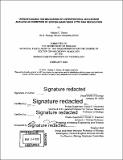Understanding the mechanism of antiretroviral nucleoside analogs as inhibitors of Epstein-Barr virus lytic DNA replication
Author(s)
Drosu, Natalia C.
Download1202775592-MIT.pdf (9.042Mb)
Other Contributors
Massachusetts Institute of Technology. Department of Biology.
Advisor
David E. Housman and Elazer R. Edelman.
Terms of use
Metadata
Show full item recordAbstract
Epstein-Barr virus (EBV) is a human B-cell tropic double-stranded DNA y-herpesvirus. To date, there are no antiviral agents proven to be clinically effective in the treatment of EBV infection or EBV-associated diseases. In the experiments contained in this thesis, we define the ability of nucleoside/nucleotide analogs licensed for the treatment of HIV to inhibit EBV lytic DNA replication in vitro. Using an established system of EBV lytic DNA replication in HH514-16 cells induced with butyrate, we validate azidothymidine (AZT) as an inhibitor of EBV lytic DNA replication. We further demonstrate that several antiretroviral nucleoside/nucleotide analogs, including stavudine (d4T), abacavir (ABC), tenofovir disoproxil fumarate (TDF) and tenofovir alafenamide (TAF), effectively inhibit EBV DNA replication. Inhibition of DNA replication by these compounds is specific to the lytic cycle, and primarily attributable to effects on the viral DNA polymerase by drug-triphosphates, except in the case of AZT. We extend studies of the tenofovir prodrugs TDF and TAF to show that these compounds are not only effective, but highly potent inhibitors of EBV lytic DNA replication. TAF has a 35- and 24-fold, and TDF has a 10- and 7-fold lower IC. than acyclovir and penciclovir, respectively. TAF is also twice as potent as the [beta]-herpesviral drug ganciclovir. In vitro, the active metabolite of TDF and TAF, tenofovir-diphosphate, is more potent than acyclovirtriphosphate at inhibiting dNTP incorporation into a DNA template by the EBV DNA polymerase. A functional consequence of bypassing viral-dependent drug metabolism is the ability to initiate treatment prior to the viral lytic cycle. Additionally, we include a clinical case report of a patient with relapsing-remitting multiple sclerosis who experienced symptomatic and radiologic improvement with Combivir (AZT/3TC), and suggest these effects may be mediated via effects on EBV. These studies highlight the need for further investigation and detailed characterization of antiviral agents for EBV and other herpesviruses. The framework presented in this thesis provides an experimental approach for testing candidate nucleoside/nucleotide analogs and probing their interactions with both cellular and viral targets. This work may inform the selection of drugs for clinical translation in the treatment of EBV infection and EBV-associated diseases.
Description
Thesis: Ph. D., Massachusetts Institute of Technology, Department of Biology, 2020 Cataloged from PDF of thesis. Includes bibliographical references (pages 169-185).
Date issued
2020Department
Massachusetts Institute of Technology. Department of BiologyPublisher
Massachusetts Institute of Technology
Keywords
Biology.